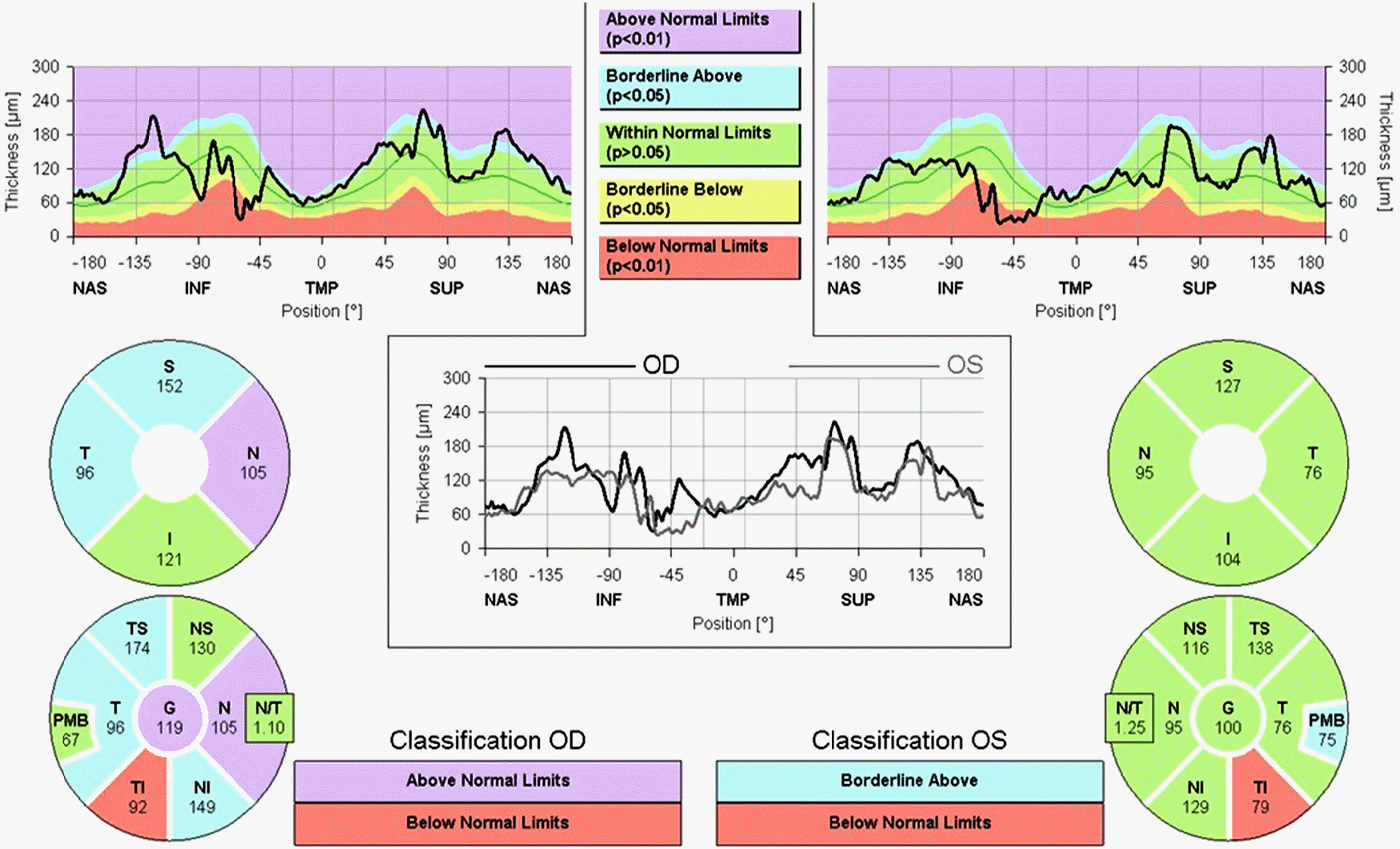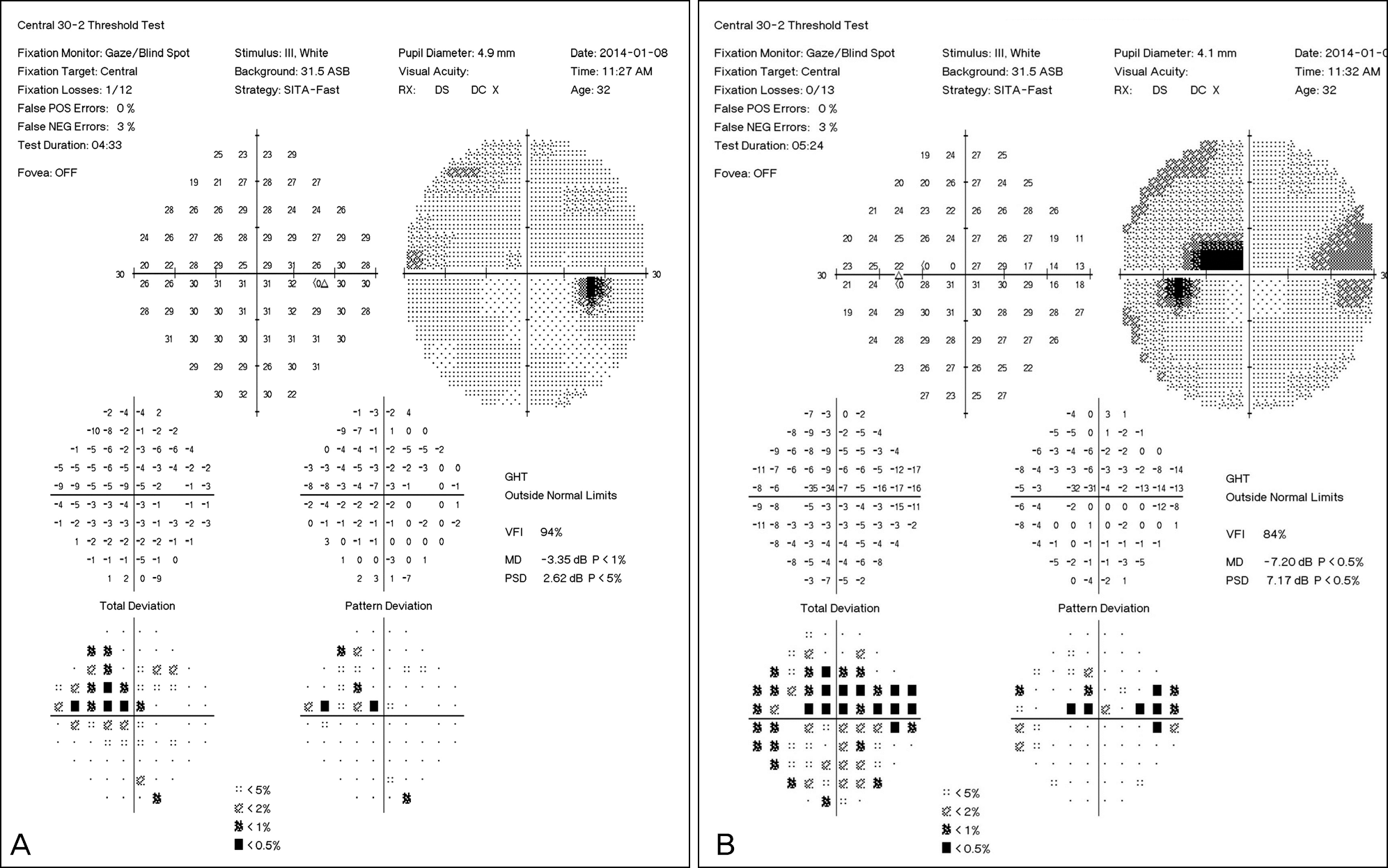Abstract
Purpose
Radius-Maumenee syndrome (RMS) is characterized by idiopathic dilated episcleral vessels usually associated with glaucoma. The authors report a case of a 32-year-old Korean male with dilation of the episcleral vessels and glaucoma in both eyes.
Case summary
A 32-year-old Korean male presented with conjunctival injection and chronic pulsatile ocular pain in both eyes for 11 years. His best corrected visual acuity was 20/20 in both eyes. Slit lamp biomicroscopy showed episcleral venous en-gorgement in both eyes. Fundus photographs revealed superotemporal and inferotemporal retinal nerve fiber layer defects and Humphrey visual field testing showed superior nasal steps and paracentral scotomas in both eyes. He suffered from chronic eye pain in both eyes although he had applied glaucoma medication and his symptoms had worsened during the past year. Brain magnetic resonance imaging (MRI) and magnetic resonance angiography (MRA) revealed no evidence of carotid cavernous fis-tula or other orbital lesions. Due to the presence of episcleral venous engorgement, glaucoma and negative tests for other possi-ble diseases, he was diagnosed with RMS.
References
1. Radius RL, Maumenee AE. Dilated episcleral vessels and open-an-gle glaucoma. Am J Ophthalmol. 1978; 86:31–5.

2. Acaroglu G, Eranil S, Ozdamar Y. . Idiopathic episcleral ve-nous engorgement. Clin Exp Optom. 2009; 92:507–10.

3. Stock RA, Fernandes NL, Pastro NL. . Idiopathic dilated epis-cleral vessels (Radius-Maumenee syndrome): case report. Arq Bras Oftalmol. 2013; 76:45–7.

4. Parikh RS, Desai S, Kothari K. Dilated episcleral veins with secon-dary open angle glaucoma. Indian J Ophthalmol. 2011; 59:153–5.

5. Grieshaber MC, Dubler B, Knodel C. . Retrobulbar blood flow in idiopathic dilated episcleral veins and glaucoma. Klin Monbl Augenheilkd. 2007; 224:320–3.
6. Lee JJ, Yap EY. Optociliary shunt vessels in diabetes mellitus. Singapore Med J. 2004; 45:166–9.
7. Lämmer R. Secondary open angle glaucoma with idiopathic epis-cleral venous pressure (Radius-Maumenee syndrome). Sinus-oto-my as operative procedure of choice. Ophthalmologe. 2007; 104:515–6.
Figure 1.
Anterior segment photographs of both eyes. (A, B) Right eye shows mild episcleral vessel engorgement. (C, D) Left eye shows prominent episcleral vessel engorgement.

Figure 2.
Red-free retinal nerve fiber layer photographs of both eyes. (A) The right eye shows superotemporal and inferotemporal retinal nerve fiber layer defects. (B) The left eye shows superotemporal and inferotemporal retinal nerve fiber layer defects, tortuous retinal vessels, optociliary shunt vessels and disc hemorrhage.

Figure 3.
Optical coherence tomography of both eyes. Definite inferotemporal retinal nerve fiber layer defects and relative superior temporal retinal nerve fiber layer thinning are found in both eyes. OD = oculus dexter; OS = oculus sinister; NAS = nasal; INF = inferior; TMP = temporal; SUP = superior; T = temporal; S = superior; N = nasal; I = inferior; TS = superotemporal; NS = superonasal; G = general; TI = inferotemporal; NI = inferonasal; PMB = papillomacular bundle; N/T = nasal/temporal ratio.

Figure 4.
Humphrey visual field testing of both eyes. Superior nasal steps and paracentral scotomas are found in both eyes. (A) Right eye (B) Left eye. SITA = Swedish Interactive Threshold Algorithm; ASB = apostilb; GHT = glaucoma hemifield test; VFI = visu-al field index; MD = mean deviation; PSD = pattern standard deviation.





 PDF
PDF ePub
ePub Citation
Citation Print
Print


 XML Download
XML Download